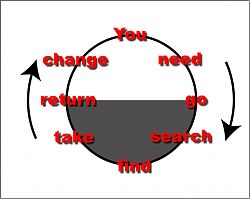
A few days ago I had a conversation about Channel101.com and found out that Dan Harmon was one of the creators of the network. I knew about Channel101.com, somehow knew that Rob Schrab was one of the creators, but never knew that Dan Harmon was involved. That conversation sparked a memory of some good articles on story structure on the Channel101.com site and, after a quick search, I found them and realized that Dan Harmon wrote them, which makes it even worse that I had no idea he was involved with the site. Oops.
The articles are a great summary of how to write good story structure. Dan Harmon distills the concepts from Joseph Campbell’s The Hero With a Thousand Faces into a simple diagram. He argues that all good stories follow his diagram, whether they are epic films like The Matrix and Die Hard, television shows (following the diagram within each episode and, hopefully, longer arcs between episodes), sports games, or even simply stories about your day.
For Dan Harmon, it’s not just theory. He has been obsessed with these concepts for years and he uses the diagram to map out all of his writing. Within an episode of Community, the overall story is mapped to the diagram. Each character’s mental journey within the episode is mapped to the diagram. In the articles, he even gives ideas for mapping individual actions within a scene to the diagram.
It is interesting to take this concept and apply it to other stories throughout your day. Watching an episode of your favorite show? See if the plot follows the diagram. At the movies? Try to identify the plot points from the diagram (don’t try this with a Michael Bay film). Is your girlfriend telling you how her bitchy coworker was mean to her? If it is a good story, it will probably fit the diagram. If she is just venting, it might not fit so well — but I do not recommend mentioning anything about story structure, she might get the mistaken impression you are not listening.
Here are the links to the articles:
- Story Structure 101: Super Basic Shit
- Story Structure 102: Pure, Boring Theory
- Story Structure 103:Let’s Simplify Before Moving On
- Story Structure 104: The Juicy Details
- Story Structure 105: How TV Is Different
- Story Structure 106: Five Minute Plots
Interested in learning more about Joseph Campbell and his monomyth theory? You could buy his book (it’s a great book). Or, if you’re feeling lazy, watch this six-minute video of puppets explaining the monomyth archetypes using Happy Gilmore as the concluding example.
